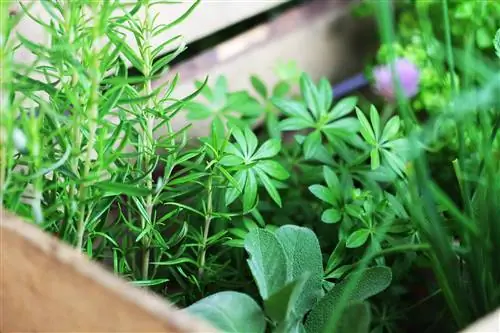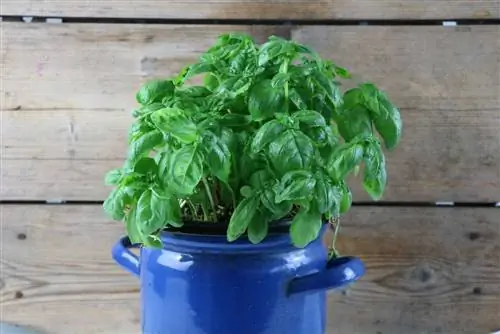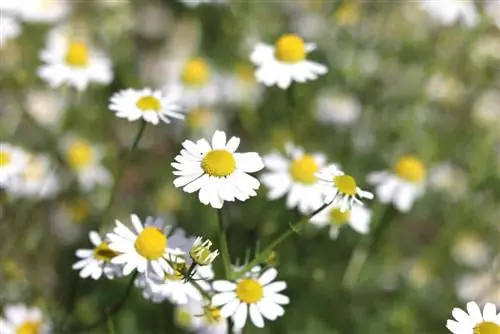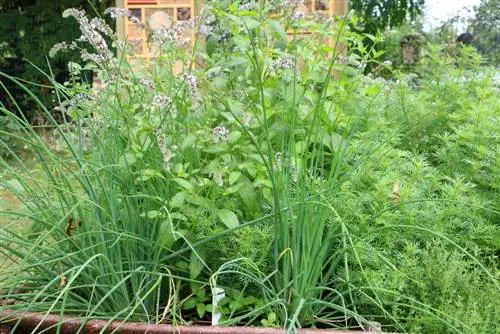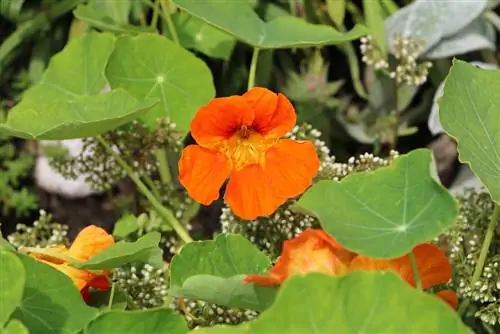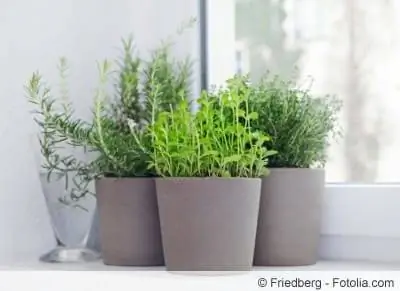- Author admin [email protected].
- Public 2023-12-17 03:39.
- Last modified 2025-06-01 06:48.
The list of culinary herbs that you can cultivate not far from your own cooking area is pleasantly long. Choose your favorite herbs from our overview so that there is no crowd on the windowsill.
List of suitable culinary herbs
The following list is intended to give you a quick overview of which herbs can generally thrive in the kitchen. But each species has special needs that need to be met. And of course every window sill is blessed differently with space, light and warmth. So every desired herb discovered on the list must be checked again to see whether it is really suitable for your own kitchen.
Basil - Ocimum basilicum

Italian cuisine is very popular and people also like to cook it at home. Whether pizza or pasta - basil is a must! Dried and frozen basil both lag far behind freshly harvested branches in terms of aroma. Luckily, basil is listed in our overview. The herb must be cared for properly, because only then will its shoots grow powerfully and become aromatic.
It requires:
- a sunny, warm place on the windowsill
- nutrient-rich soil, such as vegetable soil
- regular fertilizer applications
- Always evenly moist soil, without waterlogging after watering
Tip:
Never just pluck off individual leaves, but rather harvest entire shoots. Always cut them just above a new pair of leaves. At this interface the basil can branch and sprout new leaves.
Savory - Satureja
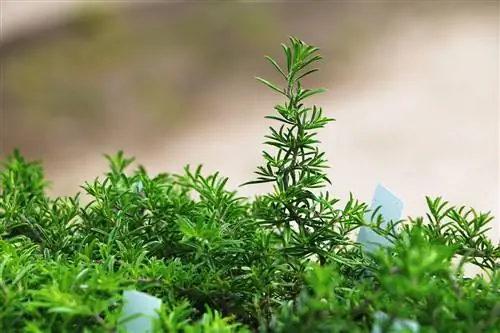
If the windowsill in the kitchen is warm and sunny, savory can thrive on it and produce a satisfactory harvest. But for he althy and reasonably lush growth in the house, good soil and a drainage layer made of pottery shards or expanded clay are also essential. The herb can be bought as a young plant or grown cheaply from seeds from the beginning of April.
Dill - Anethum graveolens
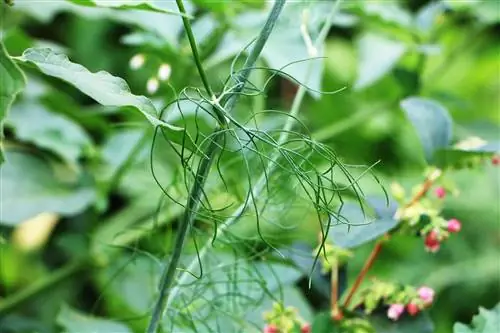
Pots of fresh dill are rarely found in the kitchen. But its cultivation is very possible if the following conditions are met:
- high planter, because it has deep roots
- loose soil and drainage layer
- partially shaded or bright location
- generous space around it, as shoots are sensitive
- Temperatures above 10 °C
- Water from below
Chervil - Anthriscus Cerefolium
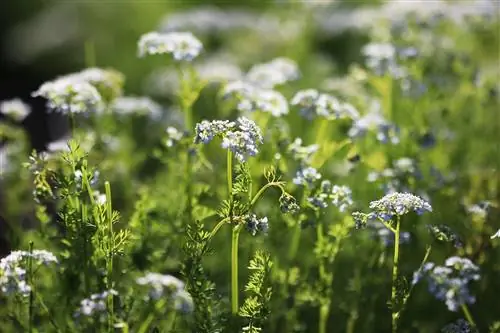
The spicy herb loves partial shade. If it has such a location in the kitchen, your own harvest is secured. Chervil can be grown from seeds from mid-March. Chervil plants are available all year round in well-stocked supermarkets. The herb requires:
- moderately moist soil
- permeable, nutrient-rich substrate
- if applicable Add some sand
- only a little fertilizer
Coriander - Coriandrum sativum
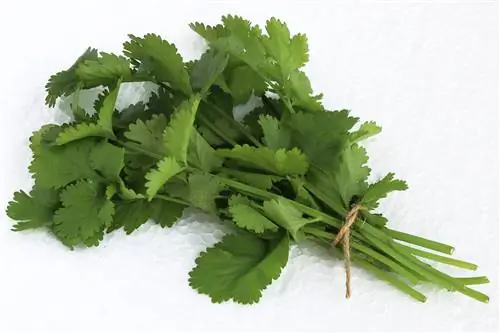
Coriander is as popular in Asia as parsley is here. Asian cuisine lovers prefer to use it fresh. He will accept an apartment as a garden replacement if he finds the following living conditions in it:
- a sunny, warm place by the south window
- nutrient-rich substrate
- regular watering
- no waterlogging (drainage layer essential!)
Tip:
Not only the green shoots and leaves are edible. Coriander seeds, from which the annual herb is grown every spring, are also used in Asian cuisine. They have a slightly sweet taste.
Cress - Lepidium sativum

Many herbs have to wait a long time after sowing. Not on the cress. Within a few days, the fine brown seeds have grown into spicy greens. The key points of cultivation in the kitchen:
- Sowing in a shallow tray
- on kitchen paper or cotton wool
- keep moist throughout
Tip:
As soon as the first leaves have formed after the cotyledons, cress can and should be harvested promptly.
Oregano - Origanum
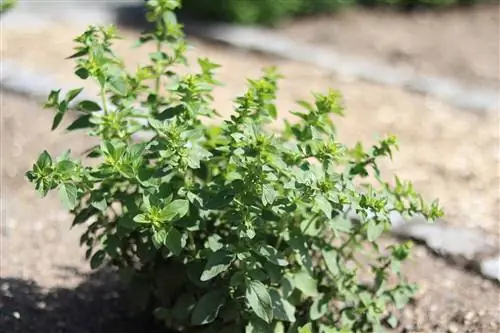
Oregano prefers to grow outside in the garden because there it can live out its strong urge to spread. The herb has to stay smaller in the pot, but still produces more shoots and greenery than most other culinary herbs.
- ideal for sunny windowsill
- single into several pots after sowing
- water regularly but cautiously
Parsley - Petroselinum crispum
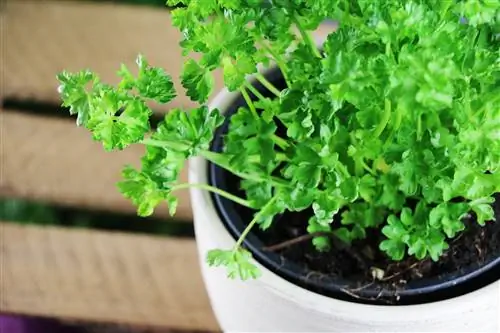
The most popular culinary herb loves the bright windowsill, but doesn't want to get direct sun. Parsley can be sown or purchased early. Flat-leaf parsley is considered more aromatic, while curly parsley has a higher decorative value.
- use good, nutrient-rich soil
- fertilize regularly (high nutrient requirements)
- water sparingly
Tip:
In the second year, once flowers begin to form, you should no longer harvest. Then the plant usually dies. Avoid harvest gaps by reseeding parsley every year.
Peppermint - Mentha x piperita
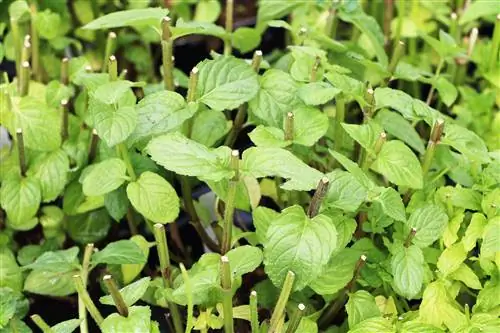
Peppermint is easier to grow than other mints. Freshly picked, it makes a delicious, he althy tea.
- likes semi-shady to shady locations
- needs loose, nutrient-rich soil
- needs to be fertilized regularly
- needs a lot of water / is also suitable for hydroponics
- should be repotted every three years (grows strongly)
Rosemary - Rosmarinus officinalis
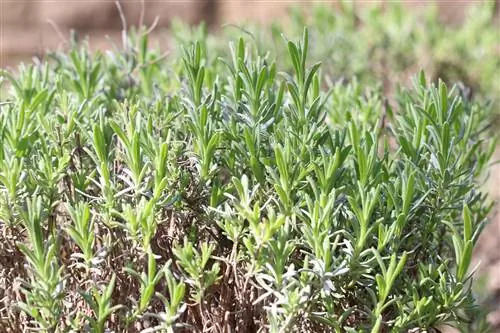
The perennial rosemary requires little space when young and can stand comfortably on the kitchen windowsill. It later develops into a larger subshrub.
- full sunny spot guarantees intense aroma
- Use a nutrient-poor substrate
- water and fertilize rarely
- repot every 3-4 years in a larger pot
Sage - Salvia officinalis
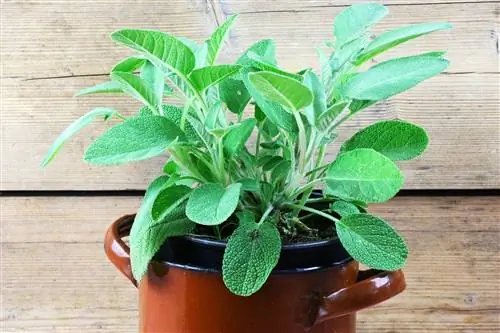
Sage also deals with sun and drought masterfully. In the house it is therefore optimally placed on the south window. If the kitchen is in an inconvenient location, he should avoid it and use the windowsill in the living room instead.
- only water when the top layer has dried
- plant in nutrient-poor soil
- for example in herb soil
- fertilize very sparingly
Chives - Allium schoenoprasum
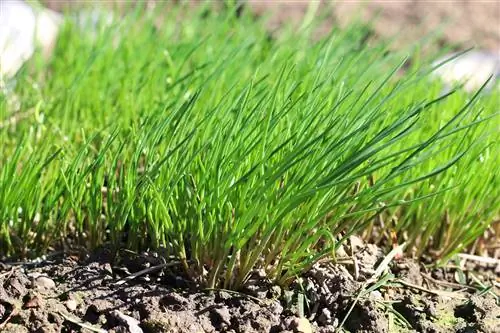
Chives can be sown indoors any day of the year. Only about six weeks later he offered the first straws for kitchen use. It's only quicker with a pre-grown plant from the supermarket.
- likes bright, airy places
- in summer in front of a regularly opened window
- likes moist soil and needs to be watered often
- After sowing, transplant early into nutrient-rich soil
- fertilize regularly
- harvest older stalks first
- cut at the base
Tip:
Chives are perennial. However, since it grows densely, it doesn't feel comfortable in the pot for long. This is also noticeable in his growth. It should therefore be re-sown regularly. Best from fresh seeds, as older seeds lose their ability to germinate.
Thyme - Thymus vulgaris
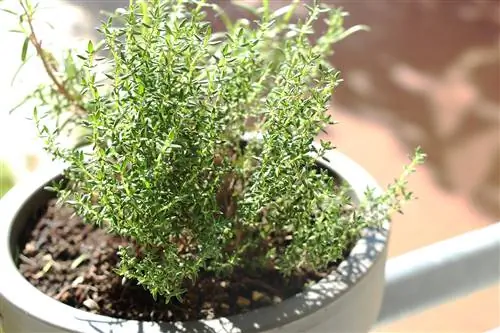
Thyme is a Mediterranean herb with few requirements. He feels comfortable on warm, sunny windowsills. If you have a balcony, you should treat yourself to an outdoor stay in the summer. The greatest danger to his life is a well-intentioned oversupply.
- plant in nutrient-poor soil
- fertilize rarely and sparingly
- water little, only when the soil dries
Lemon balm - Melissa officinalis
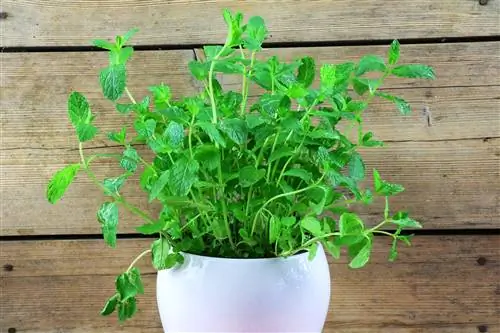
The bushy growing lemon balm needs some space as well as plenty of light and warmth. The sun-drenched south side is the best address for you. Sowing is possible from mid-March. The herb remains green even in winter and can be harvested.
- ideal pot is round, has a volume of 2 l and a depth of 15-20 cm
- Drain holes prevent waterlogging
- Use nutrient-rich, well-drained soil
- create a drainage layer at the bottom
- water regularly
- spray the green in spring and summer
- Replace substrate once a year
Tips for the indoor herb garden
Culinary herbs that are permanently kept indoors usually lag behind outdoor specimens in terms of growth. To at least get the most out of it, you should heed the following tips:
- Repot purchased herb plants in new soil as soon as possible
- Do not plant pots too closely, 1-2 plants per pot are enough
- There should be no crowding on the windowsill
- if applicable Reduce herb selection
- provide tailored care for each herb
- harvest with clean cutting tools
- Remove wilted leaves and shoots as quickly as possible
- check regularly for pests
- If possible, put herbs out on the balcony in summer
- use only organic fertilizer due to edibility
- Remove flower bases immediately (aroma robbers)
- Keep perennial herbs cooler in winter (hibernation)

